Warehouse Group: Strategic Change & Stakeholder Relationship Report
VerifiedAdded on 2023/05/28
|7
|1347
|174
Report
AI Summary
This report elucidates the internal and external stakeholders of The Warehouse Group, analyzing their interests during organizational change. It identifies employees, shareholders, and management as internal stakeholders, and consumers and competitors as external stakeholders. The report examines how strategic changes, such as integrating mobile technology, impact stakeholders and explores strategies for managing these relationships. These strategies include mobile point of sale systems, meetings, cloud-based mPOS, email communication, and in-store navigation. Effective documentation is also highlighted as a crucial tool for managing stakeholder relations during organizational changes. The report concludes that these strategies are vital for navigating organizational change and maintaining positive stakeholder relationships at The Warehouse Group. Desklib provides access to this and other solved assignments for students.

Running head: MANAGING CHANGE IN THE WAREHOUSE GROUP
Managing Change in The Warehouse Group
Name of the student
Name of the University
Author note
Managing Change in The Warehouse Group
Name of the student
Name of the University
Author note
Paraphrase This Document
Need a fresh take? Get an instant paraphrase of this document with our AI Paraphraser
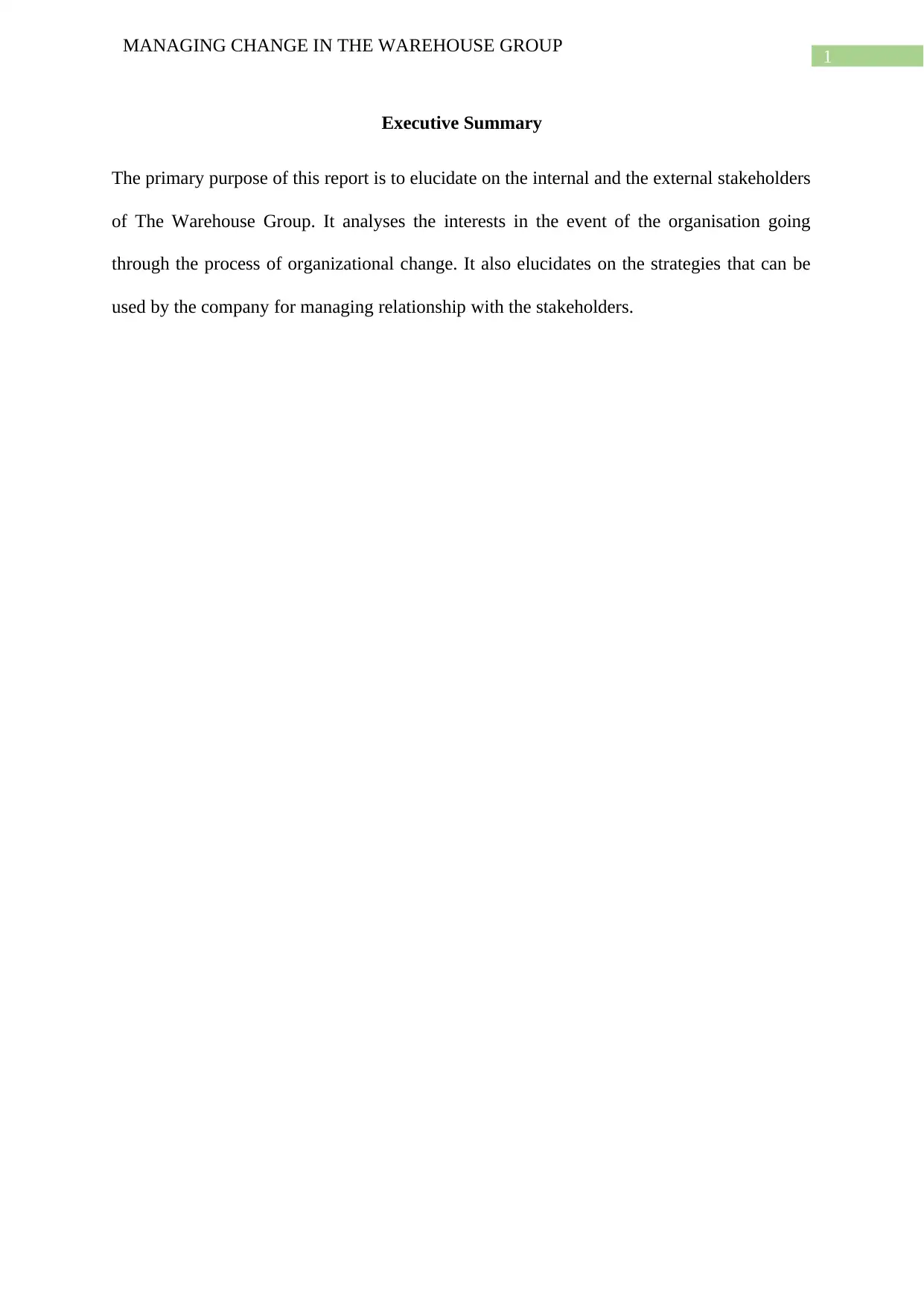
1
MANAGING CHANGE IN THE WAREHOUSE GROUP
Executive Summary
The primary purpose of this report is to elucidate on the internal and the external stakeholders
of The Warehouse Group. It analyses the interests in the event of the organisation going
through the process of organizational change. It also elucidates on the strategies that can be
used by the company for managing relationship with the stakeholders.
MANAGING CHANGE IN THE WAREHOUSE GROUP
Executive Summary
The primary purpose of this report is to elucidate on the internal and the external stakeholders
of The Warehouse Group. It analyses the interests in the event of the organisation going
through the process of organizational change. It also elucidates on the strategies that can be
used by the company for managing relationship with the stakeholders.
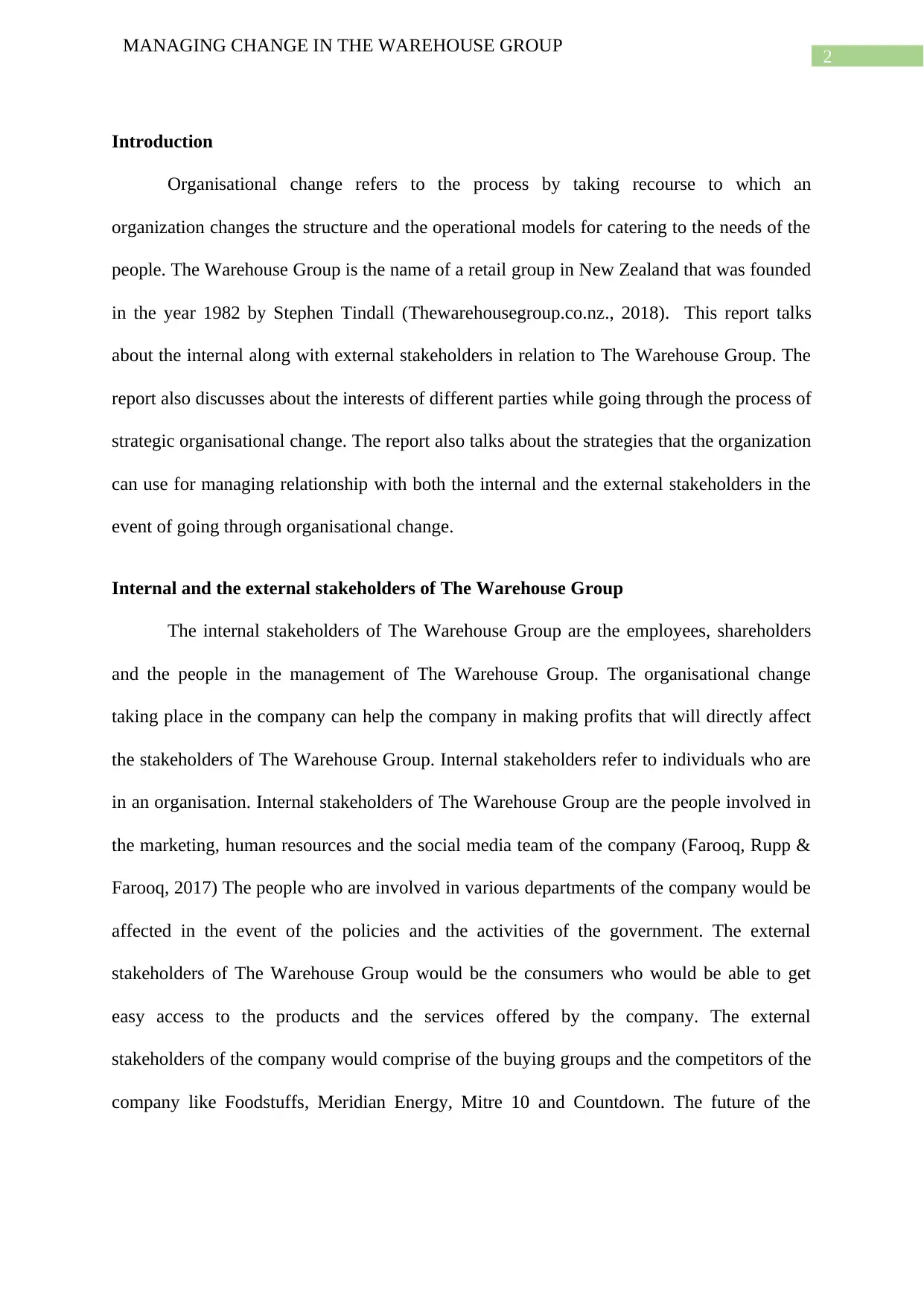
2
MANAGING CHANGE IN THE WAREHOUSE GROUP
Introduction
Organisational change refers to the process by taking recourse to which an
organization changes the structure and the operational models for catering to the needs of the
people. The Warehouse Group is the name of a retail group in New Zealand that was founded
in the year 1982 by Stephen Tindall (Thewarehousegroup.co.nz., 2018). This report talks
about the internal along with external stakeholders in relation to The Warehouse Group. The
report also discusses about the interests of different parties while going through the process of
strategic organisational change. The report also talks about the strategies that the organization
can use for managing relationship with both the internal and the external stakeholders in the
event of going through organisational change.
Internal and the external stakeholders of The Warehouse Group
The internal stakeholders of The Warehouse Group are the employees, shareholders
and the people in the management of The Warehouse Group. The organisational change
taking place in the company can help the company in making profits that will directly affect
the stakeholders of The Warehouse Group. Internal stakeholders refer to individuals who are
in an organisation. Internal stakeholders of The Warehouse Group are the people involved in
the marketing, human resources and the social media team of the company (Farooq, Rupp &
Farooq, 2017) The people who are involved in various departments of the company would be
affected in the event of the policies and the activities of the government. The external
stakeholders of The Warehouse Group would be the consumers who would be able to get
easy access to the products and the services offered by the company. The external
stakeholders of the company would comprise of the buying groups and the competitors of the
company like Foodstuffs, Meridian Energy, Mitre 10 and Countdown. The future of the
MANAGING CHANGE IN THE WAREHOUSE GROUP
Introduction
Organisational change refers to the process by taking recourse to which an
organization changes the structure and the operational models for catering to the needs of the
people. The Warehouse Group is the name of a retail group in New Zealand that was founded
in the year 1982 by Stephen Tindall (Thewarehousegroup.co.nz., 2018). This report talks
about the internal along with external stakeholders in relation to The Warehouse Group. The
report also discusses about the interests of different parties while going through the process of
strategic organisational change. The report also talks about the strategies that the organization
can use for managing relationship with both the internal and the external stakeholders in the
event of going through organisational change.
Internal and the external stakeholders of The Warehouse Group
The internal stakeholders of The Warehouse Group are the employees, shareholders
and the people in the management of The Warehouse Group. The organisational change
taking place in the company can help the company in making profits that will directly affect
the stakeholders of The Warehouse Group. Internal stakeholders refer to individuals who are
in an organisation. Internal stakeholders of The Warehouse Group are the people involved in
the marketing, human resources and the social media team of the company (Farooq, Rupp &
Farooq, 2017) The people who are involved in various departments of the company would be
affected in the event of the policies and the activities of the government. The external
stakeholders of The Warehouse Group would be the consumers who would be able to get
easy access to the products and the services offered by the company. The external
stakeholders of the company would comprise of the buying groups and the competitors of the
company like Foodstuffs, Meridian Energy, Mitre 10 and Countdown. The future of the
⊘ This is a preview!⊘
Do you want full access?
Subscribe today to unlock all pages.

Trusted by 1+ million students worldwide
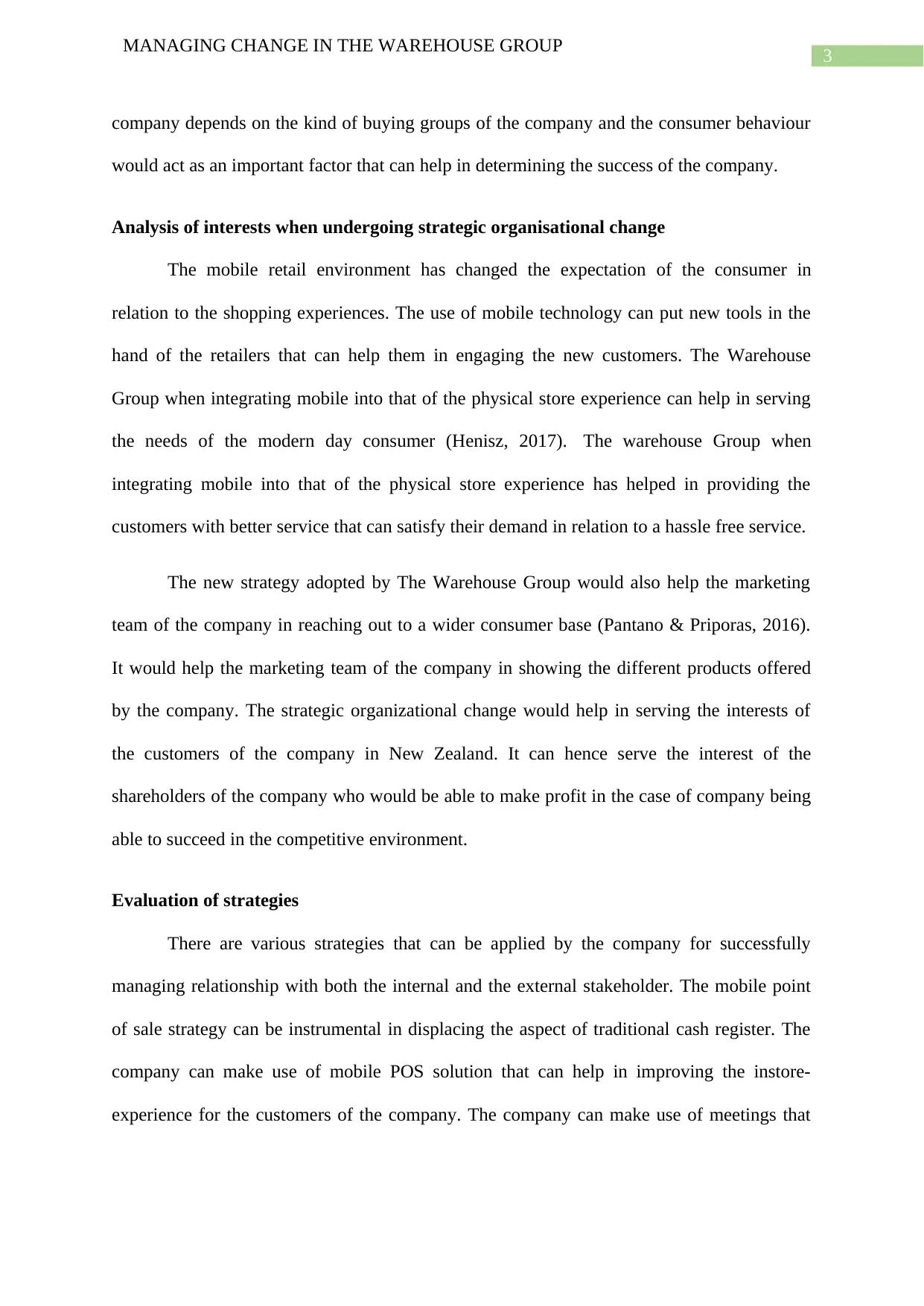
3
MANAGING CHANGE IN THE WAREHOUSE GROUP
company depends on the kind of buying groups of the company and the consumer behaviour
would act as an important factor that can help in determining the success of the company.
Analysis of interests when undergoing strategic organisational change
The mobile retail environment has changed the expectation of the consumer in
relation to the shopping experiences. The use of mobile technology can put new tools in the
hand of the retailers that can help them in engaging the new customers. The Warehouse
Group when integrating mobile into that of the physical store experience can help in serving
the needs of the modern day consumer (Henisz, 2017). The warehouse Group when
integrating mobile into that of the physical store experience has helped in providing the
customers with better service that can satisfy their demand in relation to a hassle free service.
The new strategy adopted by The Warehouse Group would also help the marketing
team of the company in reaching out to a wider consumer base (Pantano & Priporas, 2016).
It would help the marketing team of the company in showing the different products offered
by the company. The strategic organizational change would help in serving the interests of
the customers of the company in New Zealand. It can hence serve the interest of the
shareholders of the company who would be able to make profit in the case of company being
able to succeed in the competitive environment.
Evaluation of strategies
There are various strategies that can be applied by the company for successfully
managing relationship with both the internal and the external stakeholder. The mobile point
of sale strategy can be instrumental in displacing the aspect of traditional cash register. The
company can make use of mobile POS solution that can help in improving the instore-
experience for the customers of the company. The company can make use of meetings that
MANAGING CHANGE IN THE WAREHOUSE GROUP
company depends on the kind of buying groups of the company and the consumer behaviour
would act as an important factor that can help in determining the success of the company.
Analysis of interests when undergoing strategic organisational change
The mobile retail environment has changed the expectation of the consumer in
relation to the shopping experiences. The use of mobile technology can put new tools in the
hand of the retailers that can help them in engaging the new customers. The Warehouse
Group when integrating mobile into that of the physical store experience can help in serving
the needs of the modern day consumer (Henisz, 2017). The warehouse Group when
integrating mobile into that of the physical store experience has helped in providing the
customers with better service that can satisfy their demand in relation to a hassle free service.
The new strategy adopted by The Warehouse Group would also help the marketing
team of the company in reaching out to a wider consumer base (Pantano & Priporas, 2016).
It would help the marketing team of the company in showing the different products offered
by the company. The strategic organizational change would help in serving the interests of
the customers of the company in New Zealand. It can hence serve the interest of the
shareholders of the company who would be able to make profit in the case of company being
able to succeed in the competitive environment.
Evaluation of strategies
There are various strategies that can be applied by the company for successfully
managing relationship with both the internal and the external stakeholder. The mobile point
of sale strategy can be instrumental in displacing the aspect of traditional cash register. The
company can make use of mobile POS solution that can help in improving the instore-
experience for the customers of the company. The company can make use of meetings that
Paraphrase This Document
Need a fresh take? Get an instant paraphrase of this document with our AI Paraphraser
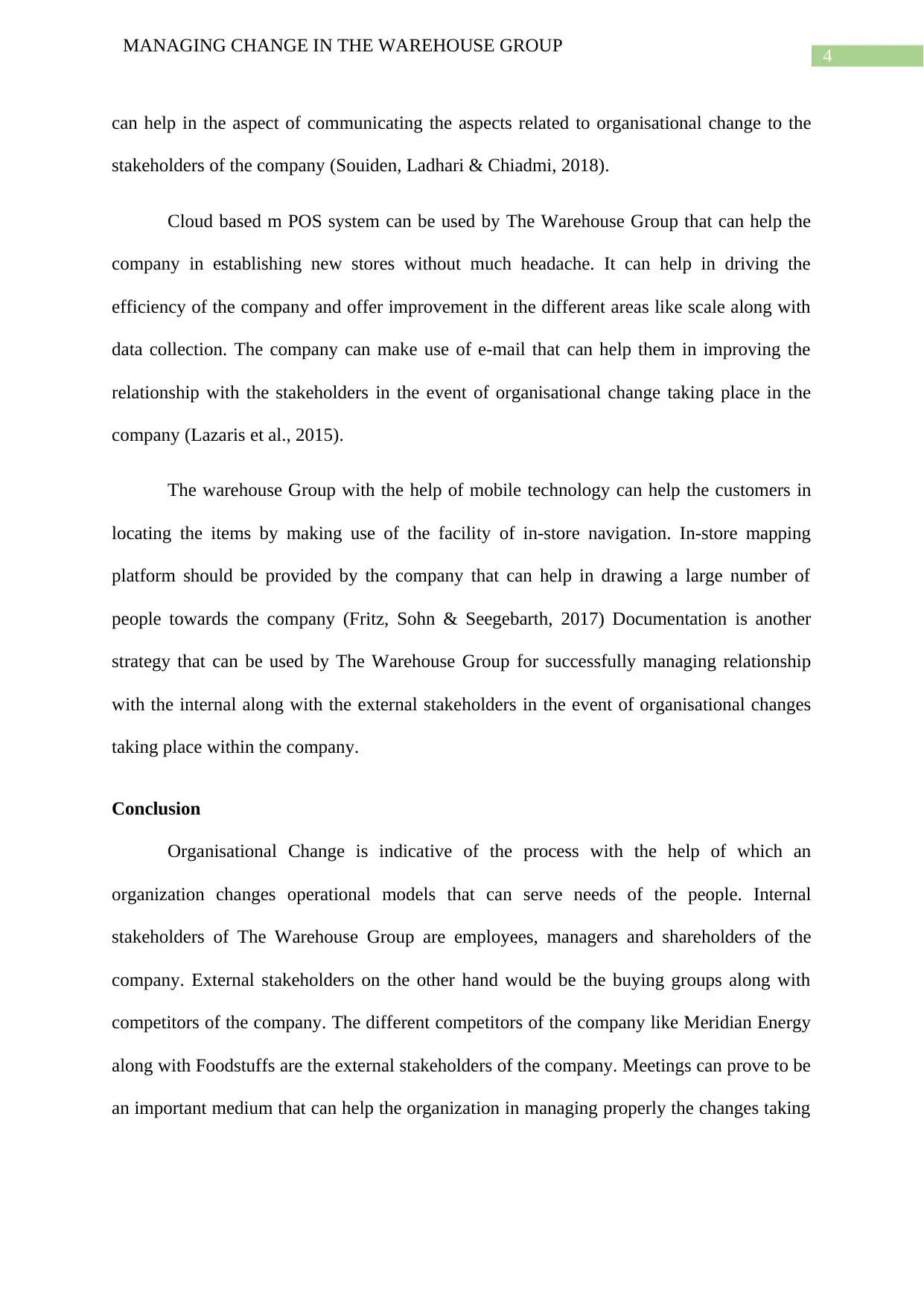
4
MANAGING CHANGE IN THE WAREHOUSE GROUP
can help in the aspect of communicating the aspects related to organisational change to the
stakeholders of the company (Souiden, Ladhari & Chiadmi, 2018).
Cloud based m POS system can be used by The Warehouse Group that can help the
company in establishing new stores without much headache. It can help in driving the
efficiency of the company and offer improvement in the different areas like scale along with
data collection. The company can make use of e-mail that can help them in improving the
relationship with the stakeholders in the event of organisational change taking place in the
company (Lazaris et al., 2015).
The warehouse Group with the help of mobile technology can help the customers in
locating the items by making use of the facility of in-store navigation. In-store mapping
platform should be provided by the company that can help in drawing a large number of
people towards the company (Fritz, Sohn & Seegebarth, 2017) Documentation is another
strategy that can be used by The Warehouse Group for successfully managing relationship
with the internal along with the external stakeholders in the event of organisational changes
taking place within the company.
Conclusion
Organisational Change is indicative of the process with the help of which an
organization changes operational models that can serve needs of the people. Internal
stakeholders of The Warehouse Group are employees, managers and shareholders of the
company. External stakeholders on the other hand would be the buying groups along with
competitors of the company. The different competitors of the company like Meridian Energy
along with Foodstuffs are the external stakeholders of the company. Meetings can prove to be
an important medium that can help the organization in managing properly the changes taking
MANAGING CHANGE IN THE WAREHOUSE GROUP
can help in the aspect of communicating the aspects related to organisational change to the
stakeholders of the company (Souiden, Ladhari & Chiadmi, 2018).
Cloud based m POS system can be used by The Warehouse Group that can help the
company in establishing new stores without much headache. It can help in driving the
efficiency of the company and offer improvement in the different areas like scale along with
data collection. The company can make use of e-mail that can help them in improving the
relationship with the stakeholders in the event of organisational change taking place in the
company (Lazaris et al., 2015).
The warehouse Group with the help of mobile technology can help the customers in
locating the items by making use of the facility of in-store navigation. In-store mapping
platform should be provided by the company that can help in drawing a large number of
people towards the company (Fritz, Sohn & Seegebarth, 2017) Documentation is another
strategy that can be used by The Warehouse Group for successfully managing relationship
with the internal along with the external stakeholders in the event of organisational changes
taking place within the company.
Conclusion
Organisational Change is indicative of the process with the help of which an
organization changes operational models that can serve needs of the people. Internal
stakeholders of The Warehouse Group are employees, managers and shareholders of the
company. External stakeholders on the other hand would be the buying groups along with
competitors of the company. The different competitors of the company like Meridian Energy
along with Foodstuffs are the external stakeholders of the company. Meetings can prove to be
an important medium that can help the organization in managing properly the changes taking
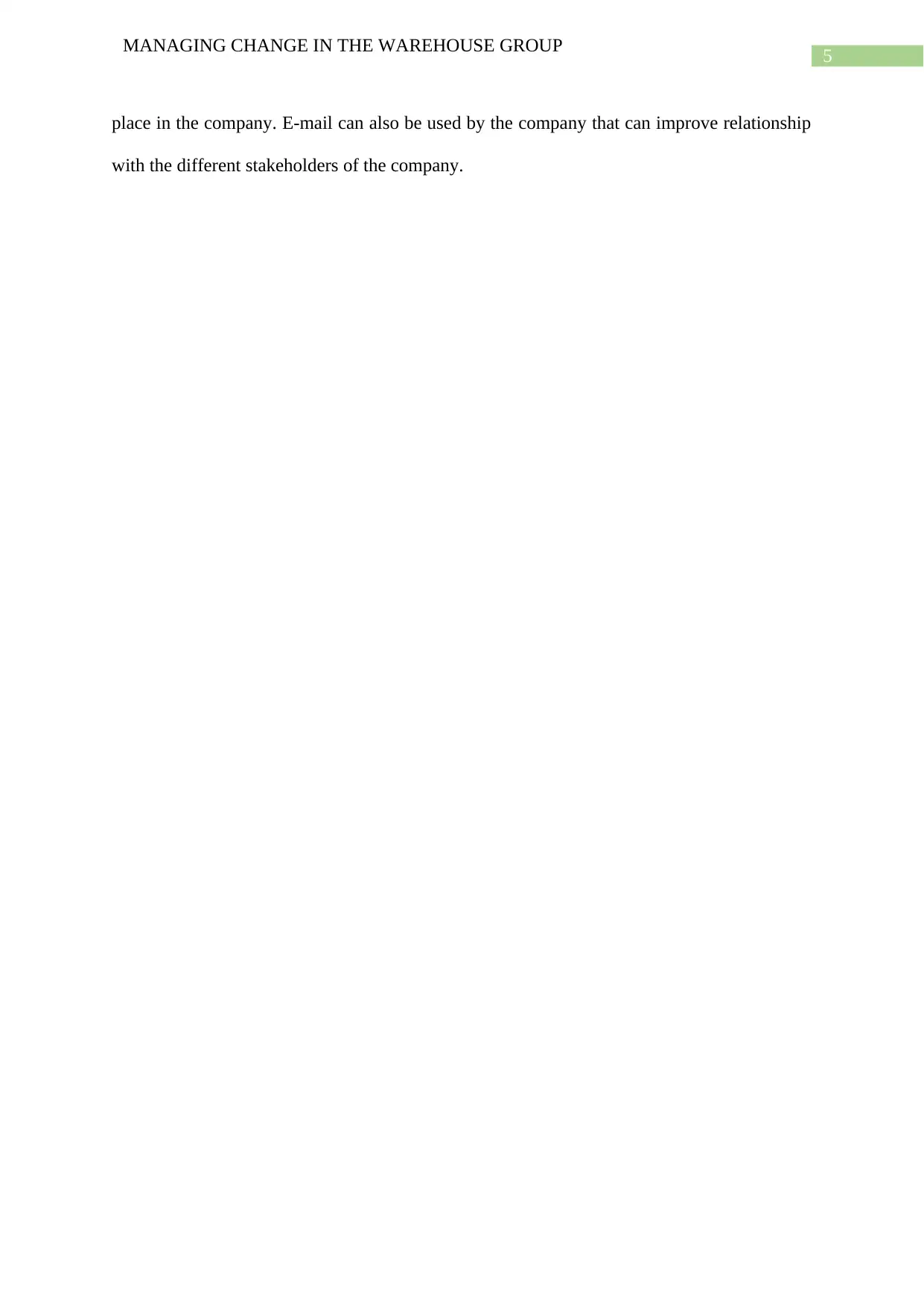
5
MANAGING CHANGE IN THE WAREHOUSE GROUP
place in the company. E-mail can also be used by the company that can improve relationship
with the different stakeholders of the company.
MANAGING CHANGE IN THE WAREHOUSE GROUP
place in the company. E-mail can also be used by the company that can improve relationship
with the different stakeholders of the company.
⊘ This is a preview!⊘
Do you want full access?
Subscribe today to unlock all pages.

Trusted by 1+ million students worldwide
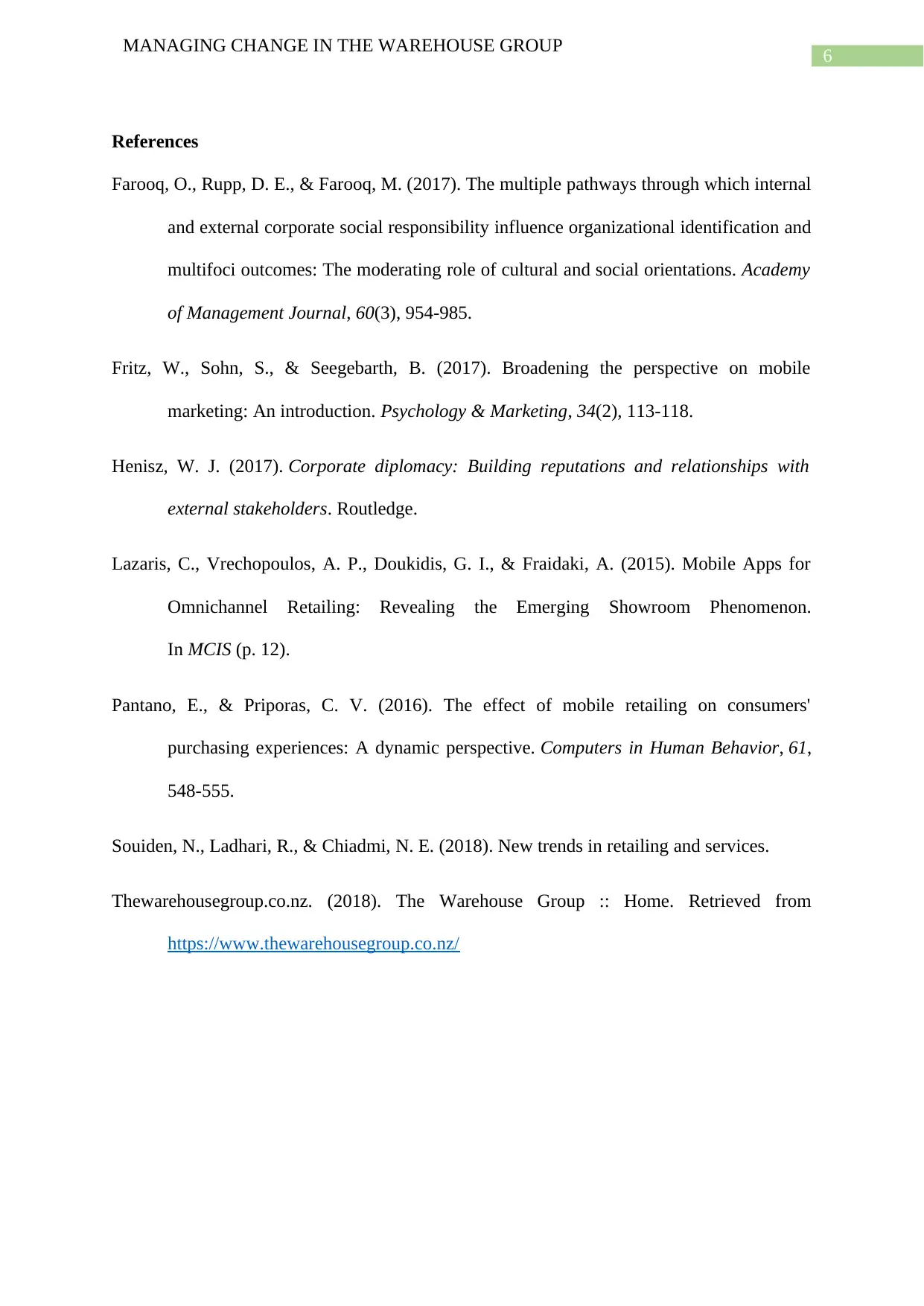
6
MANAGING CHANGE IN THE WAREHOUSE GROUP
References
Farooq, O., Rupp, D. E., & Farooq, M. (2017). The multiple pathways through which internal
and external corporate social responsibility influence organizational identification and
multifoci outcomes: The moderating role of cultural and social orientations. Academy
of Management Journal, 60(3), 954-985.
Fritz, W., Sohn, S., & Seegebarth, B. (2017). Broadening the perspective on mobile
marketing: An introduction. Psychology & Marketing, 34(2), 113-118.
Henisz, W. J. (2017). Corporate diplomacy: Building reputations and relationships with
external stakeholders. Routledge.
Lazaris, C., Vrechopoulos, A. P., Doukidis, G. I., & Fraidaki, A. (2015). Mobile Apps for
Omnichannel Retailing: Revealing the Emerging Showroom Phenomenon.
In MCIS (p. 12).
Pantano, E., & Priporas, C. V. (2016). The effect of mobile retailing on consumers'
purchasing experiences: A dynamic perspective. Computers in Human Behavior, 61,
548-555.
Souiden, N., Ladhari, R., & Chiadmi, N. E. (2018). New trends in retailing and services.
Thewarehousegroup.co.nz. (2018). The Warehouse Group :: Home. Retrieved from
https://www.thewarehousegroup.co.nz/
MANAGING CHANGE IN THE WAREHOUSE GROUP
References
Farooq, O., Rupp, D. E., & Farooq, M. (2017). The multiple pathways through which internal
and external corporate social responsibility influence organizational identification and
multifoci outcomes: The moderating role of cultural and social orientations. Academy
of Management Journal, 60(3), 954-985.
Fritz, W., Sohn, S., & Seegebarth, B. (2017). Broadening the perspective on mobile
marketing: An introduction. Psychology & Marketing, 34(2), 113-118.
Henisz, W. J. (2017). Corporate diplomacy: Building reputations and relationships with
external stakeholders. Routledge.
Lazaris, C., Vrechopoulos, A. P., Doukidis, G. I., & Fraidaki, A. (2015). Mobile Apps for
Omnichannel Retailing: Revealing the Emerging Showroom Phenomenon.
In MCIS (p. 12).
Pantano, E., & Priporas, C. V. (2016). The effect of mobile retailing on consumers'
purchasing experiences: A dynamic perspective. Computers in Human Behavior, 61,
548-555.
Souiden, N., Ladhari, R., & Chiadmi, N. E. (2018). New trends in retailing and services.
Thewarehousegroup.co.nz. (2018). The Warehouse Group :: Home. Retrieved from
https://www.thewarehousegroup.co.nz/
1 out of 7
Related Documents
Your All-in-One AI-Powered Toolkit for Academic Success.
+13062052269
info@desklib.com
Available 24*7 on WhatsApp / Email
![[object Object]](/_next/static/media/star-bottom.7253800d.svg)
Unlock your academic potential
Copyright © 2020–2025 A2Z Services. All Rights Reserved. Developed and managed by ZUCOL.




